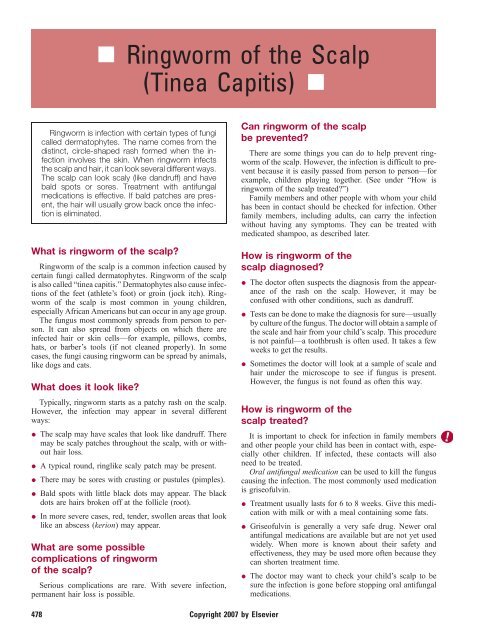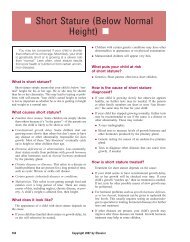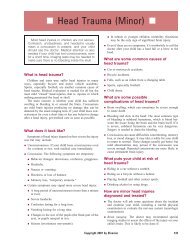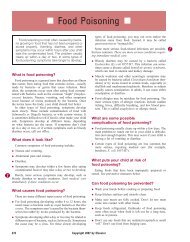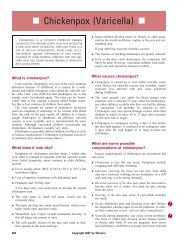Ringworm of the Scalp (Tinea Capitis) - Nelson Instructions Pediatric ...
Ringworm of the Scalp (Tinea Capitis) - Nelson Instructions Pediatric ...
Ringworm of the Scalp (Tinea Capitis) - Nelson Instructions Pediatric ...
You also want an ePaper? Increase the reach of your titles
YUMPU automatically turns print PDFs into web optimized ePapers that Google loves.
n <strong>Ringworm</strong> <strong>of</strong> <strong>the</strong> <strong>Scalp</strong><br />
(<strong>Tinea</strong> <strong>Capitis</strong>) n<br />
<strong>Ringworm</strong> is infection with certain types <strong>of</strong> fungi<br />
called dermatophytes. The name comes from <strong>the</strong><br />
distinct, circle-shaped rash formed when <strong>the</strong> infection<br />
involves <strong>the</strong> skin. When ringworm infects<br />
<strong>the</strong> scalp and hair, it can look several different ways.<br />
The scalp can look scaly (like dandruff) and have<br />
bald spots or sores. Treatment with antifungal<br />
medications is effective. If bald patches are present,<br />
<strong>the</strong> hair will usually grow back once <strong>the</strong> infection<br />
is eliminated.<br />
What is ringworm <strong>of</strong> <strong>the</strong> scalp?<br />
<strong>Ringworm</strong> <strong>of</strong> <strong>the</strong> scalp is a common infection caused by<br />
certain fungi called dermatophytes. <strong>Ringworm</strong> <strong>of</strong> <strong>the</strong> scalp<br />
is also called “tinea capitis.” Dermatophytes also cause infections<br />
<strong>of</strong> <strong>the</strong> feet (athlete’s foot) or groin (jock itch). <strong>Ringworm</strong><br />
<strong>of</strong> <strong>the</strong> scalp is most common in young children,<br />
especially African Americans but can occur in any age group.<br />
The fungus most commonly spreads from person to person.<br />
It can also spread from objects on which <strong>the</strong>re are<br />
infected hair or skin cells—for example, pillows, combs,<br />
hats, or barber’s tools (if not cleaned properly). In some<br />
cases, <strong>the</strong> fungi causing ringworm can be spread by animals,<br />
like dogs and cats.<br />
What does it look like?<br />
Typically, ringworm starts as a patchy rash on <strong>the</strong> scalp.<br />
However, <strong>the</strong> infection may appear in several different<br />
ways:<br />
The scalp may have scales that look like dandruff. There<br />
may be scaly patches throughout <strong>the</strong> scalp, with or without<br />
hair loss.<br />
A typical round, ringlike scaly patch may be present.<br />
There may be sores with crusting or pustules (pimples).<br />
Bald spots with little black dots may appear. The black<br />
dots are hairs broken <strong>of</strong>f at <strong>the</strong> follicle (root).<br />
In more severe cases, red, tender, swollen areas that look<br />
like an abscess (kerion) may appear.<br />
What are some possible<br />
complications <strong>of</strong> ringworm<br />
<strong>of</strong> <strong>the</strong> scalp?<br />
Serious complications are rare. With severe infection,<br />
permanent hair loss is possible.<br />
Can ringworm <strong>of</strong> <strong>the</strong> scalp<br />
be prevented?<br />
There are some things you can do to help prevent ringworm<br />
<strong>of</strong> <strong>the</strong> scalp. However, <strong>the</strong> infection is difficult to prevent<br />
because it is easily passed from person to person—for<br />
example, children playing toge<strong>the</strong>r. (See under “How is<br />
ringworm <strong>of</strong> <strong>the</strong> scalp treated?”)<br />
Family members and o<strong>the</strong>r people with whom your child<br />
has been in contact should be checked for infection. O<strong>the</strong>r<br />
family members, including adults, can carry <strong>the</strong> infection<br />
without having any symptoms. They can be treated with<br />
medicated shampoo, as described later.<br />
How is ringworm <strong>of</strong> <strong>the</strong><br />
scalp diagnosed?<br />
The doctor <strong>of</strong>ten suspects <strong>the</strong> diagnosis from <strong>the</strong> appearance<br />
<strong>of</strong> <strong>the</strong> rash on <strong>the</strong> scalp. However, it may be<br />
confused with o<strong>the</strong>r conditions, such as dandruff.<br />
Tests can be done to make <strong>the</strong> diagnosis for sure—usually<br />
by culture <strong>of</strong> <strong>the</strong> fungus. The doctor will obtain a sample <strong>of</strong><br />
<strong>the</strong> scale and hair from your child’s scalp. This procedure<br />
is not painful—a toothbrush is <strong>of</strong>ten used. It takes a few<br />
weeks to get <strong>the</strong> results.<br />
Sometimes <strong>the</strong> doctor will look at a sample <strong>of</strong> scale and<br />
hair under <strong>the</strong> microscope to see if fungus is present.<br />
However, <strong>the</strong> fungus is not found as <strong>of</strong>ten this way.<br />
How is ringworm <strong>of</strong> <strong>the</strong><br />
scalp treated?<br />
It is important to check for infection in family members<br />
and o<strong>the</strong>r people your child has been in contact with, especially<br />
o<strong>the</strong>r children. If infected, <strong>the</strong>se contacts will also<br />
need to be treated.<br />
Oral antifungal medication can be used to kill <strong>the</strong> fungus<br />
causing <strong>the</strong> infection. The most commonly used medication<br />
is grise<strong>of</strong>ulvin.<br />
Treatment usually lasts for 6 to 8 weeks. Give this medication<br />
with milk or with a meal containing some fats.<br />
Grise<strong>of</strong>ulvin is generally a very safe drug. Newer oral<br />
antifungal medications are available but are not yet used<br />
widely. When more is known about <strong>the</strong>ir safety and<br />
effectiveness, <strong>the</strong>y may be used more <strong>of</strong>ten because <strong>the</strong>y<br />
can shorten treatment time.<br />
The doctor may want to check your child’s scalp to be<br />
sure <strong>the</strong> infection is gone before stopping oral antifungal<br />
medications.<br />
!<br />
478<br />
Copyright 2007 by Elsevier
<strong>Ringworm</strong> <strong>of</strong> <strong>the</strong> <strong>Scalp</strong> n 479<br />
Antifungal shampoos are used along with oral medications.<br />
These shampoos can help remove scale from <strong>the</strong> scalp<br />
and may help prevent spreading <strong>the</strong> infection to o<strong>the</strong>rs.<br />
However, <strong>the</strong>y are not as important as <strong>the</strong> oral medications<br />
and are not very effective treatment on <strong>the</strong>ir own.<br />
Some <strong>of</strong> <strong>the</strong>se products contain selenium sulfide (for<br />
example, Selsun Blue) or zinc pyrithione (for example,<br />
Head & Shoulders).<br />
Most experts recommend antifungal shampoos for family<br />
members <strong>of</strong> an infected patient. This is because family<br />
members may be “carriers”—<strong>the</strong>y have <strong>the</strong> fungus on<br />
<strong>the</strong>ir scalps, but no symptoms <strong>of</strong> <strong>the</strong> infection. Treatment<br />
with shampoos can kill <strong>the</strong> fungus and possibly reduce or<br />
prevent <strong>the</strong> spread <strong>of</strong> infection.<br />
When should I call your <strong>of</strong>fice?<br />
Call our <strong>of</strong>fice if:<br />
Your child’s scalp rash isn’t eliminated after treatment.<br />
Scaling and o<strong>the</strong>r problems return.<br />
O<strong>the</strong>r children who may have ringworm <strong>of</strong> <strong>the</strong> scalp, or<br />
who have some type <strong>of</strong> rash or o<strong>the</strong>r symptoms—on<br />
<strong>the</strong> scalp or elsewhere on <strong>the</strong> body—should be seen by<br />
<strong>the</strong> doctor.<br />
Copyright 2007 by Elsevier


